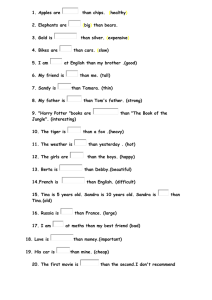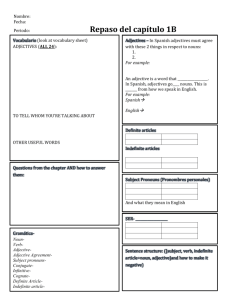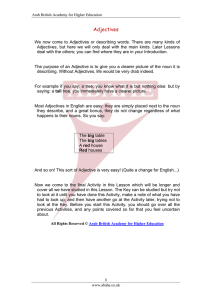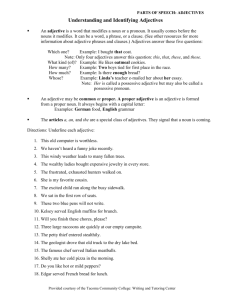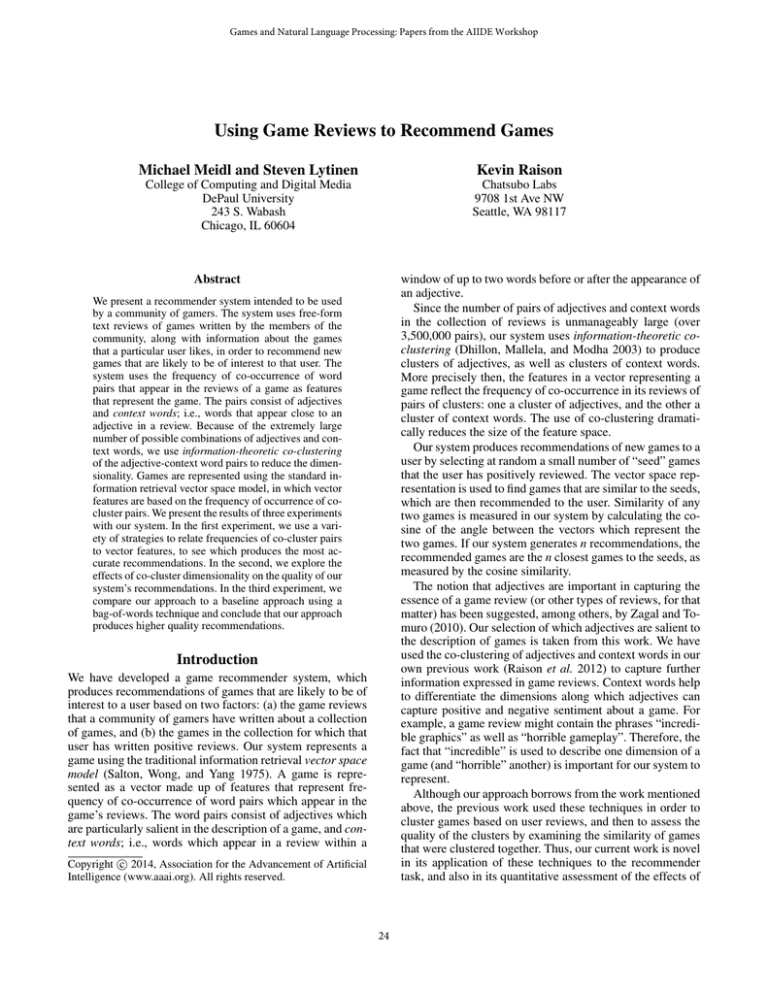
Games and Natural Language Processing: Papers from the AIIDE Workshop
Using Game Reviews to Recommend Games
Michael Meidl and Steven Lytinen
Kevin Raison
College of Computing and Digital Media
DePaul University
243 S. Wabash
Chicago, IL 60604
Chatsubo Labs
9708 1st Ave NW
Seattle, WA 98117
Abstract
window of up to two words before or after the appearance of
an adjective.
Since the number of pairs of adjectives and context words
in the collection of reviews is unmanageably large (over
3,500,000 pairs), our system uses information-theoretic coclustering (Dhillon, Mallela, and Modha 2003) to produce
clusters of adjectives, as well as clusters of context words.
More precisely then, the features in a vector representing a
game reflect the frequency of co-occurrence in its reviews of
pairs of clusters: one a cluster of adjectives, and the other a
cluster of context words. The use of co-clustering dramatically reduces the size of the feature space.
Our system produces recommendations of new games to a
user by selecting at random a small number of “seed” games
that the user has positively reviewed. The vector space representation is used to find games that are similar to the seeds,
which are then recommended to the user. Similarity of any
two games is measured in our system by calculating the cosine of the angle between the vectors which represent the
two games. If our system generates n recommendations, the
recommended games are the n closest games to the seeds, as
measured by the cosine similarity.
The notion that adjectives are important in capturing the
essence of a game review (or other types of reviews, for that
matter) has been suggested, among others, by Zagal and Tomuro (2010). Our selection of which adjectives are salient to
the description of games is taken from this work. We have
used the co-clustering of adjectives and context words in our
own previous work (Raison et al. 2012) to capture further
information expressed in game reviews. Context words help
to differentiate the dimensions along which adjectives can
capture positive and negative sentiment about a game. For
example, a game review might contain the phrases “incredible graphics” as well as “horrible gameplay”. Therefore, the
fact that “incredible” is used to describe one dimension of a
game (and “horrible” another) is important for our system to
represent.
Although our approach borrows from the work mentioned
above, the previous work used these techniques in order to
cluster games based on user reviews, and then to assess the
quality of the clusters by examining the similarity of games
that were clustered together. Thus, our current work is novel
in its application of these techniques to the recommender
task, and also in its quantitative assessment of the effects of
We present a recommender system intended to be used
by a community of gamers. The system uses free-form
text reviews of games written by the members of the
community, along with information about the games
that a particular user likes, in order to recommend new
games that are likely to be of interest to that user. The
system uses the frequency of co-occurrence of word
pairs that appear in the reviews of a game as features
that represent the game. The pairs consist of adjectives
and context words; i.e., words that appear close to an
adjective in a review. Because of the extremely large
number of possible combinations of adjectives and context words, we use information-theoretic co-clustering
of the adjective-context word pairs to reduce the dimensionality. Games are represented using the standard information retrieval vector space model, in which vector
features are based on the frequency of occurrence of cocluster pairs. We present the results of three experiments
with our system. In the first experiment, we use a variety of strategies to relate frequencies of co-cluster pairs
to vector features, to see which produces the most accurate recommendations. In the second, we explore the
effects of co-cluster dimensionality on the quality of our
system’s recommendations. In the third experiment, we
compare our approach to a baseline approach using a
bag-of-words technique and conclude that our approach
produces higher quality recommendations.
Introduction
We have developed a game recommender system, which
produces recommendations of games that are likely to be of
interest to a user based on two factors: (a) the game reviews
that a community of gamers have written about a collection
of games, and (b) the games in the collection for which that
user has written positive reviews. Our system represents a
game using the traditional information retrieval vector space
model (Salton, Wong, and Yang 1975). A game is represented as a vector made up of features that represent frequency of co-occurrence of word pairs which appear in the
game’s reviews. The word pairs consist of adjectives which
are particularly salient in the description of a game, and context words; i.e., words which appear in a review within a
c 2014, Association for the Advancement of Artificial
Copyright Intelligence (www.aaai.org). All rights reserved.
24
The word “detail”, for example, appears as a context word
for the adjective “incredible” a total of 7 times in the reviews
of Grand Theft Auto IV.
Because of the extremely high number of adjectivecontext word pairs (there are potentially over 3,500,000 such
pairs in the dataset), our system uses information-theoretic
co-clustering (Dhillon, Mallela, and Modha 2003) to cluster
both adjectives and context words into subsets, in the same
way as in our previous work (Raison et al. 2012). The coclustering technique selects subsets of adjectives and of context words in such as way as to minimize the loss of information resulting from replacing single words with co-clusters.
Formally, mutual information I(x, y) of two random variables x and y 1 as follows:
co-clustering on the accuracy of the recommendations produced by the system (as discussed in the Results section below).
In the remainder of this paper, we present in more detail
the co-clustering technique and its use in generating the features that represent games in our system. We also discuss
the use of the vector space model in our system’s generation
of recommendations. Finally, we present the results of three
experiments we conducted, that demonstrate the quality of
the recommendations produced by our system. In the first
experiment, we compared the use of a variety of metrics for
relating vector features to frequencies of co-cluster pairs, to
see which metric produces the most accurate predictions. In
the second, we explored the effects of co-cluster dimensions
on the quality of our system’s recommendations. Finally, we
compared our use of word co-occurrence frequencies to a
simpler “bag-of-words” approach. The results indicate that
the use of co-clustering of word pairs is superior to bag-ofwords.
I(x, y) =
log(p(x,y))
p(x)p(y)
Information loss is defined as:
L(x, y) = I(x, y) - I(c1 , c2 )
I(x, y) is the mutual information of the lexical items x
and y, and I(c1 , c2 ) is the mutual information of the clusters
c1 and c2 , where x ∈ c1 and y ∈ c2 .
The co-clustering algorithm requires that the number
of co-clusters for both dimensions (adjectives and context
words) be specified as part of the input to the algorithm. In
the first experiment described in the Results section, we discuss the effects of varying the number of co-clusters.
In Table 1, we show some examples of a few of the
co-clusters that are generated for 30×100 co-clusters (i.e.,
30 adjective clusters and 100 context word clusters). Intuitively, it appears that clusters capture some semantic commonalities among words in a cluster, although typically not
all clustered words are synonyms or words that are obviously related to each other. For example, adjective cluster 1 in general contains words that express very positive
sentiment (“incredible”, “impressive”, “astounding”, etc.)
although there are exceptions (“mediocre”, “rounded”). In
context word cluster 1, words such as “feeling”, “mood”,
“manner”, “creepy”, and “disturbing”, while not synonyms,
all address an emotional aspect about how a game feels.
Adjective clusters sometimes contain words with opposite
sentiment, such as the inclusion in cluster 2 of “easy” and
“hard”, “single-player” and “multi-player”. A possible cause
is that adjectives with opposite sentiments often can be used
in similar contexts (e.g., “easy gameplay” vs. “hard gameplay”, or “single-player mode” vs. “multi-player mode”).
Additional a priori knowledge about positive vs. negative
sentiment that adjectives can express would be helpful in
minimizing this problem. Although use of a priori knowledge about positive or negative sentiment would be likely to
improve our system’s performance, our results indicate that
the system performs well even with imperfect clusters.
Game Reviews and Co-clusters
The corpus of game reviews that our system uses is
taken from the work of Zagal and Tomuro (2010). These
reviews were collected from the GameSpot Web site
(www.gamespot.com). The dataset contains approximately
400,000 reviews of 8,279 different games. For each game,
our system examined all of the reviews of that game, and
counted frequencies of the occurrence of selected adjectives
and their context words. The adjectives are those determined
to be the most relevant to the expression of sentiment in
game reviews (see Zagal and Tomuro 2010 for details). Context words are “open class” words (e.g., nouns and verbs, but
not prepositions) which appear in a review within a window
of up to two words before or after an adjective. In total, the
game reviews contain over 700 relevant adjectives and about
5,000 context words.
To illustrate the collection of adjective-context word pairs,
consider this excerpt from a review of Grand Theft Auto IV:
GTA 4 is a good game, the graphics are great, the gameplay is great, and the attention to detail is incredible.
The adjective-context word pairs extracted from this sentence are:
good game
great graphics
great gameplay
incredible detail
As a result of the extraction of adjective-context word
pairs, our system produces a data file for each game, containing frequency counts of each adjective-context word pair in
all of the reviews for that game. For example, here is a portion of the frequency counts for the adjective “incredible”
in the Grand Theft Auto IV reviews (this adjective appears
with too many context words to include all of them in the
list below).
Related Work
Previous work in sentiment analysis has focused on the
use of adjectives in text, for example in (Hatzivassiloglou
incredible: funny 1, play 1, detail 7, achievement 2,
soundtrack 1, look 2, details 3, graphics 8, character
1, game 12, sound 1, story 5
1
25
Here, x is an adjective and y is a context word.
Adjective
cluster 1
Adjective
cluster 2
Context word
cluster 1
Context word
cluster 2
incredible, decent, mediocre, impressive, spectacular, exceptional,
unbelievable, astonishing, remarkable, acceptable, extraordinary,
promising, astounding, rounded,
unparalleled, adequate, noteworthy,
exquisite
easy, multiplayer, hard, cooperative,
single-player, difficult, offline, casual, tricky, impossible
feel, feeling, eye, tune , scary, mood,
manner, creepy, tone, emotion, representation, ear, authentic, device,
photo, tuned, disturbing, tuning,
footstep, thick, spooky, vibe, eerie,
depiction, horrific, dandy
animation, movement, rate, frame,
framerate, pacing, ran, greatness,
stream, steady, silky, sailing, acceleration, warioware
in generating product recommendations; however, this work
did not involve the analysis of product reviews as in our own
current work.
Feature Representations in Vectors
After co-clustering, our system replaces specific adjectives
and context words in the raw frequency counts with the
co-clusters that the words are members of. Using these cocluster pairs, a game is represented as a vector, the length
of which is the product of the number of adjective coclusters times the number of context word co-clusters. For
example, in 70×100 co-clustering (the maximum dimensionality that we used), the length of each vector is potentially 7,0002 . Note that even with this relatively large number of co-clusters, the vector length is reduced by a factor
of approximately 500 from the more than 3,500,000 possible combinations of single adjectives and single context
words. Each number in the vector reflects the frequency of
co-occurrence of a word that is a member of a particular adjective cluster with a word that is a member of a particular
context word cluster.
We have experimented with a variety of approaches to
weighing each feature in the vectors, as described below.
Table 1: Examples of adjective and context-word co-clusters
in 30×100 co-clustering
boolean: Values in a game’s vector are either 1 or 0, reflecting whether or not a particular adjective/context-word cocluster combination appears in any review of that game.
and McKeown 1997; Pang and Li 2008). In other work,
co-occurrence of adjectives with nouns (e.g., “wonderful
ideas”, “horrible taste”) has been used for the purpose of
extracting more accurate or fine-grained opinions (but not
for generating recommendations). For example, Stylios et
al. (2011) extracted adjective-nouns pairs, which are in the
dependency/modifying relation, from the opinions posted at
an online forum on eGovernment for the purpose of mining the public opinions on various government decisions. In
(Archak, Ghosea, an Ipeirotis 2007), a similar approach was
used to identify consumer preferences from product reviews
posted at Amazon.
As discussed earlier, Zagal and Tomuro (2010) also used
to occurrence of adjectives in game reviews in order to cluster games using the vector space approach, based on frequency of occurrence of adjectives. They then qualitatively
analyzed the clusters in order to assess the similarities of
games that were clustered together. In our own previous
work (Raison et al. 2012), we used co-clustering of adjective and context words in the same way as in our current
work, but again the resulting vector space representation was
used to cluster games, and then a qualitative analysis of the
clusters was performed. Our current work is distinct in its
application of co-clustering to the recommender task, and in
the quantitative assessment of the accuracy of recommendations.
Co-clustering has also been used by others to capture the
dependency between two variables (or objects and features),
which are typically represented by the rows and columns of
a matrix. For example, Archak, Ghosea, and Ipeirotis (2007)
and Bisson and Hussain (2008) both applied co-clustering to
the task of document categorization, and showed improved
results as compared to the generation of clusters on a single
dimension. George and Merugu (2005) applied co-clustering
tf: Vector values are determined by counting the frequency
of co-occurrence of each adjective-context word co-cluster.
tf-idf: This is the approach that is most commonly used in information retrieval systems (Salton, 1991). Vector values are
calculated by multiplying term frequencies by the inverse
document frequency (i.e., the inverse of the number of game
reviews in which a member of an adjective cluster co-occurs
with a member of a context word cluster).
tf-normc: This is a normalized version of tf, in which each
term in the vector is normalized by dividing by the maximum value of that term over all games. In other words, this
is a column-wise normalization of vectors, as opposed to a
row-wise normalization.
max-tf: This builds on tf-normc by applying a smoothing
function to the values in a vector, as described in (Manning
et al. 2009). The smoothing function mitigates the effect of
the length of the reviews on term frequencies. For each document d, let tfmax (d) = maxτ ∈d tfτ,d , where τ ranges over
all terms in d. Then
max-tf (Gi ) = α + [(1-α) *
Gi
max(Gi ) ]
where Gi is the vector representation of game i, and α is
a variable which ranges between 0 and 1. The result of the
smoothing function is that each term weight is between α
and 1. Typically α = 21 .
2
Features whose values are 0 across all vectors are removed,
thereby shortening the vector lengths.
26
In each approach described above, similarity between two
games is measured by computing the cosine of the angle
between the vectors which represent the games. This similarity metric is typically used in IR systems (Salton 1989),
and seems appropriate in our task because our representation of games is formed from free-form text reviews (i.e.,
documents).
We evaluated the quality of our system’s recommendations by measuring their precision, in the standard information retrieval meaning of this term (Salton 1989). In our context, precision is defined as follows:
Precision =
High precision is achieved if a high percentage of games
in R are games in L, although many games in L may not be
included in R. Precision tends to vary inversely with n.4
For the experiments, we selected 10 users who had written the most reviews in our collection. We selected prolific
reviewers so that we had ample data about which games
those reviewers liked and disliked. On average the 10 users
wrote reviews of 150-200 different games. For each user, we
performed a standard k-fold cross-validation (Kohavi 1995).
That is, we divided the set of games that the user liked (L)
into k equal size folds. In each simulation a fold served as
the seeds (S); therefore k = |L|/|S|. We measured average
precision across the folds, and then calculated the average
across the 10 users. 5
In our first experiment, we varied the weighting scheme
for feature dimensions in our vector space representations of
games, using 10×100 co-clustering. Table 2 shows average
precision over values of n ranging between 1 and 10. Despite the frequent use of tf-idf in many information retrieval
systems, we found that tf-normc yielded superior performance (although tf-idf was second). The Boolean approach
was third, and would have the advantage that vector feature
values would not need to be recalculated as additional game
reviews were added to the collection. Perhaps not surprisingly, tf, which is the only metric in which no normalization
of any kind was applied, yielded the worst precision.
Generation of Recommendations
Once the system has constructed the vector space representations of the games, it generates recommendations for a particular user as follows. Of the set of games that the user has
reviewed (call this set G), the system identifies those games
that the user likes (L). Gamespot reviews include rankings
of games on a scale of 1 to 10, which our system uses (rather
than the content of the free-form text reviews) to determine
which games are in L. We chose the cut-off between liked
and disliked games to be the median ranking given by a user
to all games that s/he reviewed.
Metric
tf-normc
tf-idf
boolean
max-tf
tf
Figure 1: Illustration of the Recommendation Process
Precision
.86
.80
.74
.70
.66
Table 2: Average precision for 1-10 recommendations using
various similarity metrics
Results
Next, using tf-normc, we varied the dimensions used in
co-clustering, ranging from 10×30 (10 adjective clusters
and 30 context word clusters) to 70×100, in order to see
the effects on system performance. Figure 2 shows precision
vs. n for 10 adjective clusters, varying the number of context word clusters between 30 and 100. Similarly, Figure 3
shows precision vs. n for 30 adjective clusters. In general,
co-clustering with 70 adjective clusters (not shown) produced worse performance. The fact that co-clustering with
10 adjective clusters produced the highest precision suggests
that the vectors produced from larger numbers of adjective
We conducted three experiments in order to evaluate our system’s performance. Because we were not in a position to perform live user tests, we conducted offline experiments (Herlocker et al. 2004). In the experiments, our system selected
a small number of “seeds” (S) from the set of games L that
a user liked,3 and generated recommendations as described
in the previous section. Under normal circumstances, these
recommendations would not include games in G (i.e., games
which the user has already reviewed). However, in our experiments, recommendations were limited only to games in
G. In other words, the experimental task was: given S, can
our system accurately predict which other games are in L
and which are not?
3
|R∩L|
|R|
4
In all experiments, we tested for values of n between 1 and 10.
In machine learning parlance, S is the “training set” and L-S is
the “test set” for each fold.
5
In our experiments, |S| = 3.
27
Figure 2: Precision vs. n with 10 adjective clusters
Figure 4: Precision vs. n, comparing co-clustering and bagof-words
Conclusion
The results of our experiments suggest that our game recommender system produces high quality recommendations to
users, based on a gaming community’s reviews of games and
a particular user’s ratings of games s/he has played. As our
experiments indicate, superior performance is achieved with
the use of adjective-context word pairs (and then shrinking
the dimensionality of the vectors using co-clustering) as opposed to the use of single terms in bag-of-words. Our system’s performance is best when using small number (10) of
adjective clusters. The optimal co-clustering dimensionalities (10×100) reduces the size of the vector space by a factor of about 300 when compared to no co-clustering of word
pairs, and a factor of 5-10 compared to bag-of-words. The
latter comparison indicates that the superior performance using co-clustering is achieved despite the reduction in dimensionality.
Using 10×100 or co-clusters, and when generating a
small number of recommendations (between 1 and 10), we
found that the co-clustering approach produces precision of
.84-.86, while the precision of the bag-of-words approach is
between .75 and .79.
In future work, we plan to apply our approach to produce
recommendations in domains other than gaming. In principle our approach is applicable to any domain in which reviews (preferably detailed reviews) of products or services
are available, such as restaurants, hotels, and so on.
User reviews reveal information about the content of
games, and thus our approach is similar to other contentbased recommendation systems (Pazzani and Billsus 2007).
As stated earlier, including sentiment analysis in our approach would likely yield better results. We also plan to
compare our approach to collaborative filtering techniques
(Ricci, Rokach, and Shapira 2011).
Figure 3: Precision vs. n with 30 adjective clusters
clusters are too sparse, and therefore fail to capture important commonalities among adjectives.
Finally, in the third experiment, we compared our use of
word pair co-occurrence as features used to represent games
with a simpler “bag of words” approach. In this baseline approach, the frequency of occurrence of single words, rather
than word pairs, was used to build the vector representations of games. This seems to be an appropriate baseline
with which to compare our system because of the prevalence of “bag of words” in information retrieval systems.
Figure 4 shows a comparison of performance using 10×100
adjective-context word co-clustering (which achieved the
highest precision), the average precision for co-clustering
across all dimensions, and the bag-of-words approach. Coclustering with 10 adjective clusters results in precision of 710 percentage points higher than bag-of-words, with the average precision for co-clustering using all dimensions higher
than bag-of-words as well.
28
References
play: A Lexical Approach. In Proceedings of the 14th
International Academic MindTrek Conference: Envisioning
Future Media Environments, 9-16. New York, NY: ACM.
Archak, N. Ghosea, A., and Ipeirotis, P. 2007. Show Me
the Money! Deriving the Pricing Power of Product Features
by Mining Consumer Reviews. In Proceedings of the
Thirteenth ACM International Conference on Knowledge
Discovery and Data Mining, 56-65. New York, NY: ACM.
Dhillon, I.S., Mallela, S., and Modha, D.S. 2003.
Information-theoretic Co-clustering. In Proceedings of
the Ninth ACM SIGKDD International Conference on
Knowledge Discovery and Data Mining, 89-98. New York,
NY: ACM.
George, T. and Merugu, S. 2005. A Scalable Collaborative Filtering Framework Based on Co-clustering. In
Proceedings of the Fifth IEEE International Conference on
Data Mining, 625-628. Los Angeles, CA: IEEE Computer
Society.
Hatzivassiloglou, V., and McKeown, V. 1997. Predicting the
Semantic Orientation of Adjectives. In Proceedings of the
Eighth Conference of the European Chapter of the Association for Computational Linguistics, 174-181. Stroudsburg,
PA: Association for Computational Linguistics.
Kohavi, R. 1995. A Study of Cross-validation and Bootstrap
for Accuracy Estimation and Model Selection. In Proceedings of the Fourteenth International Joint Conference on
Artificial Intelligence, 1137-1145.
Pang, B. and Lee, L. 2008. Opinion Mining and Sentiment
Analysis. Foundations and Trends in Information Retrieval
2(1-2), 1-135.
Pazzani, M. J., & Billsus, D. (2007). Content-based Recommendation Systems. In The adaptive Web (pp. 325-341).
Springer Berlin Heidelberg.
Raison, K., Tomuro, N., Lytinen, S., and Zagal, J. 2012.
Extraction of User Opinions by Adjective-context Coclustering for Game Review Texts. In Proceedings of the
Eighth International Conference on NLP, Kanazawa, Japan,
289-299. Berlin: Springer-Verlag.
Ricci, F., Rokach, L., and Shapira, B. 2011. Introduction to
Recommender Systems Handbook. Springer U.S.
Salton, G. 1989. Automatic Text Processing: The Transformation, Analysis, and Retrieval of Information by Computer.
Boston, MA: Addison-Wesley.
Salton, G. 1991. Developments in automatic text retrieval.
Science 253, 974-979.
Salton, G., Wong, A,. and Yang, C. 1975. A Vector Space
Model for Automatic Indexing. Communications of the
ACM 18(11): 613-620.
Stylios, G., Christodoulakis, D., Besharat, J., Kotrotsos,
I., Koumpouri,A., and Stamou, S. 2011. Public opinion
mining for governmental decisions. Electronic Journal of
Electronic Government 8(2), 202-213.
Zagal, J., and Tomuro, N. 2010. The Aesthetics of Game-
29


